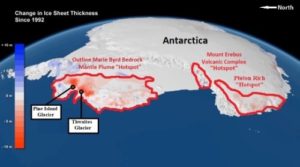by E. Utter, Apt 11, 2023 in ClimateChangeDispatch
According to a recently released study, at the end of the last ice age, parts of an enormous ice sheet covering Eurasia retreated up to 2,000 feet per day.
That rate is the fastest measured to date, far exceeding what scientists previously believed to be the upper limits for ice sheet retreat. [emphasis, links added]
In the new study, lead author Christine Batchelor and her colleagues analyzed former beds of two major ice streams across the Norwegian continental ice shelf dating back 15,000 to 19,000 years ago.
Using ship-borne imagery, the team then calculated the rates of retreat by studying patterns of wavelike ridges along the seafloor.
They hypothesized that the “orderly” ridge patterns they observed may have been created as the front of the glacier bounced on the seafloor from daily tides.
Call me a skeptic, but this doesn’t sound to me like “settled science.”
Nonetheless, Batchelor and crew think the finding may shed light on how quickly ice in Greenland and Antarctica might melt — and raise global sea levels — in a warming world.
Batchelor stated: “If temperatures continue to rise, then we might have the ice being melted and thinned from above as well as from below, so that could kind of end up with a scenario that looks more similar to what we had [off] Norway after the last glaciation.”
According to a story in The Washington Post, Eric Rignot, a glaciologist who was not involved in the study, opined on it anyway, stating via email:
“This is not a model. This is real observation. And it is frankly scary. Even to me.” (Cue the voice of Elmer Fudd. “Yes, it is vewy, vewy, scawy, Rignot.” Not.
The only thing the study proves is that the Earth warmed quickly and dramatically eons ago— without any possible help from man.
…
…



